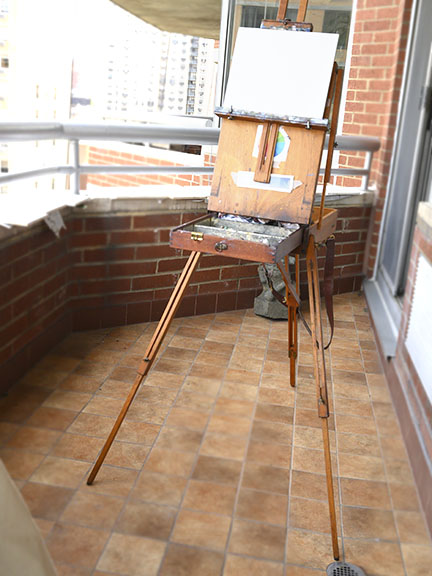
I’m a big fan of vintage art supplies. Seems that much of the stuff you get today feels like cheap knock-offs. Plus its kind of a spiritual experience using good quality materials that were used and enjoyed by another artist.
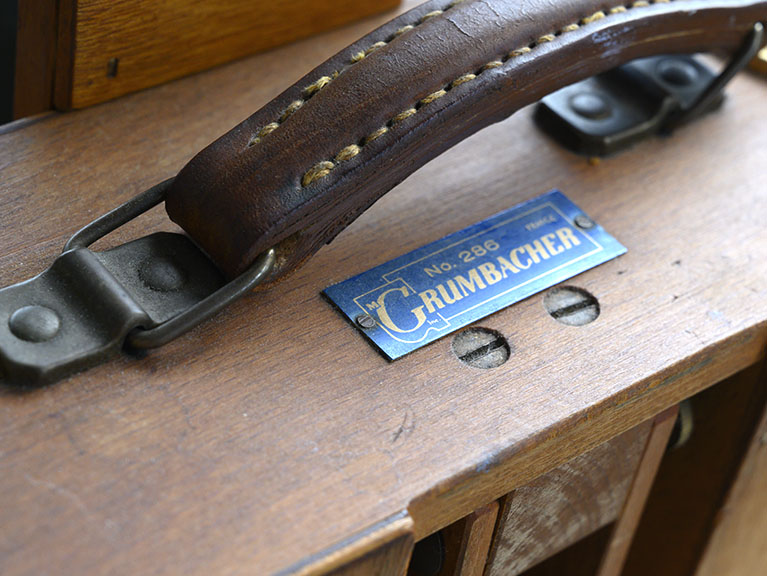
I always admired the romance of the French easel. Growing up I looked at these at Pearl Paint but they were too expensive for me. One day I saw a vintage Grumbacher #286 on eBay. When I examined the photos there was a nice patina and not too much wear, so I took the plunge and made a last-minute bid.
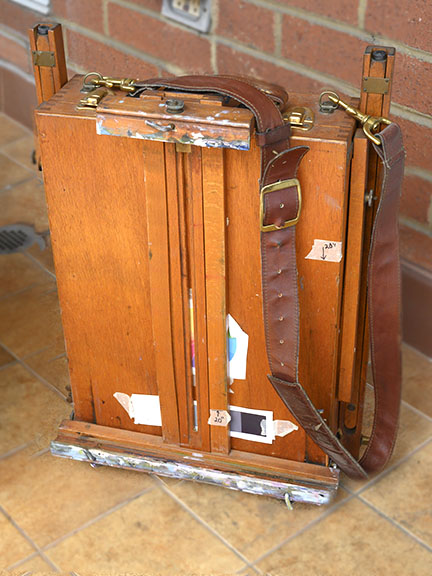
When I unpacked it I was thrilled. It had the original leather handle, as well as a barely legible impressed stamp that said “Made in France.” The carrying area for paint tubes and brushes was made of tin – something you don’t see in French easels on the market today.
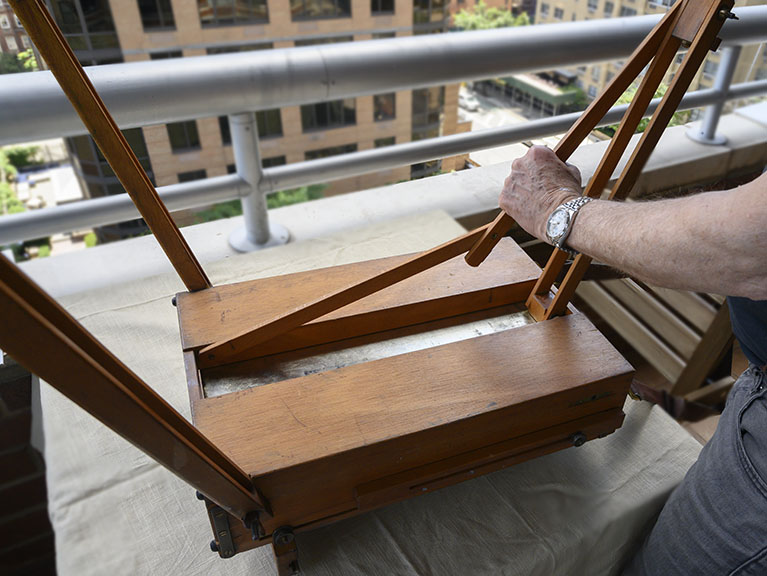
Everything was in good working condition, but there were cobwebs inside, the wood was very dry, and it smelled like someone’s attic. So I got some rags, and bought a package of light-duty steel wool and a canister of tung oil and went to work. Tung oil, from the Asian tung tree, is an environmentally safe rehabilitation treatment for woods that leaves a glowing water-resistant veneer.
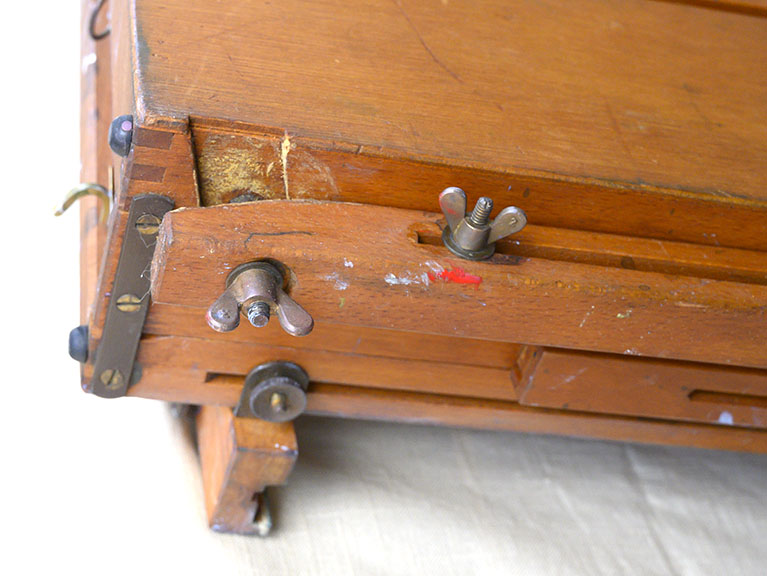
First I wiped the easel down and got rid of the dust and cobwebs, then lightly steel wooled all surfaces. I applied at least five coats of tung oil, allowing it to sink deeply into the wood. The rubber feet were dry and rotted so I found small rubber bumpers on-line and replaced them. All the hardware needed oiling down as well. When it was done I added a leather carrying strap from an old duffel bag.
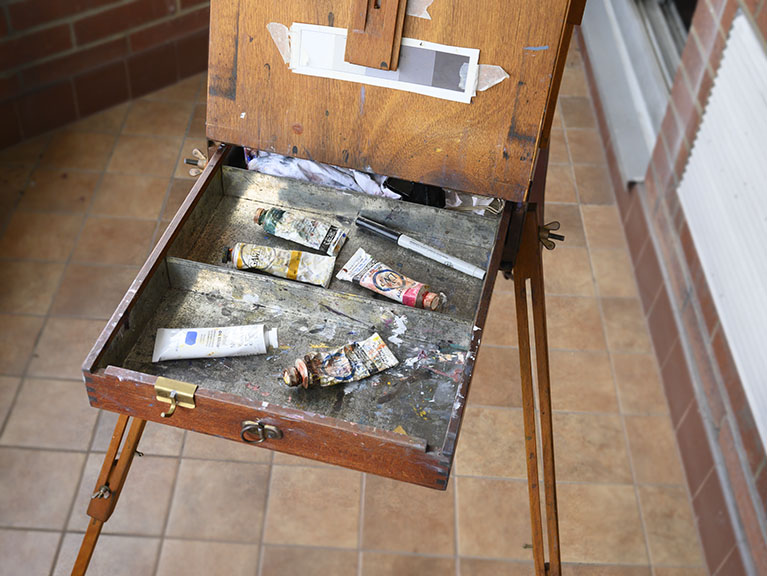
Set-up in the studio was just fine, but taking this easel out into the field was another matter. As elegant as it looks, it is heavy and clunky to carry around. It’s also ponderous to set up, and if any of the multiple thumb screws is not completely tightened you have a potential disaster on your hands. The French easel is simply no match for a good field kit like the Open Box M. What was once the state-of-the-art now seems like an idiosyncratic holdover. Still, many plein air artists use easels with this design.
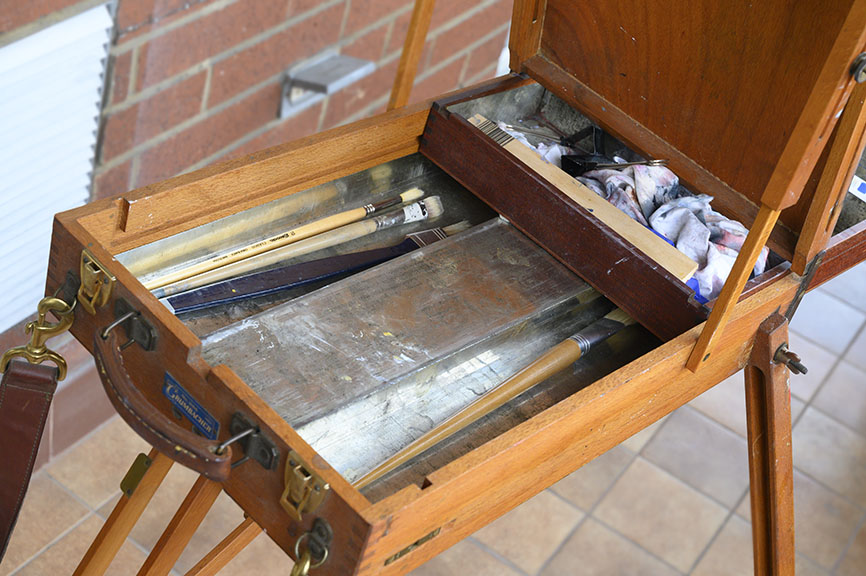
But just because it’s clunky and impractical in the field doesn’t stop me from loving this item. For a Manhattan apartment where space is a premium, it makes an excellent studio easel I can put up and take down with ease, so that’s what I use it for. I also use it for photoshoots to document my art. Now this vintage Grumbacher #286 that likely sat in storage for who-knows-how-many years is a well-loved, and well-used item in my studio.
* * * * * * * * * * * * * *
Related posts:
Plein Air Watercolor on the Esopus River
A Plein Air Setup for Large-Scale Urban Sketching
Plein Air in the Catskills with Winslow
How to Make a Custom Plein Air Palette from an Old Metal Box
End of an Era: Pearl Paint Closes
Review of a Vintage Winsor Newton Travel Palette

ua26fe
How do you keep the third leg (the one tucked into the center of the box not on the outsides) from falling down when closed? I have everything else locked into place and I know the drawer locks the box but the leg still falls… help
There is a metal snap that should keep it in place but if this wears out I don’t know how to replace it. The truth is that this easel is so fragile and rickety I use it only as a studio piece.
How does your drawer secure I picked up the same model off FB marketplace and the drawer just falls right out when you pick it up by the handle?
If I recall correctly, the drawer should seal from moving when closed. You can probably fix this with a small piece of wood pasted to the inside, but need to send me a pic of the inside.
I have the same problem and have been grappling with ways to fix it
Upon further inspection I think the palette itself is the locking mechanism. Mine is missing. I will put a piece of plywood in to see if it works.
Before you mess with it just try this:
1) open the easel revealing the drawer
2) close the drawer
3) Insert the palette
4) Close the easel and snap the clips
This should seal the drawer! If not, then those small pieces that press against the palette have been removed.
J
Any resolution to this problem? I was just given this model no. 286 french easel. Before I set it up, the drawer remained in place… but now, after opening it, the drawer slides out and off. I have the original wooden palette… but cannot figure out how to engage it to hold the drawer in place.
My thanks!
I bought my Grumbacher French easel model 286 in 1982, There is some wear and tear since I used often outside. My leather handle broke after 5 or 6 years since I got it, I did replaced the handle with heavy leather lace that make my handle. I like the quality of the wood, very strong. I used to paint pretty well every day, so my poor palette lost is original finish. I put away my easel around 2004 since I lost my inspiration to paint. Just a few day ago I opened my easel again and I started to paint again. It is still in good shape, I will not sell it. Thank you for your advised to treat the wood with tung oil. I want to keep my easel for longer time.
Thanks for the note Gerard, I wish you hours of joy with your treasure!
I have had the same easel for 49 years. How did you clean up the dried oil paint from the metal trays?
Shaloha from Kauai
Bought it in good condition so no problem with paint on the trays!!
Jeff
I inherited one of these from a family member and I want to sell it what should I ask for it?
Keep it, its a treasure. If in good condition this can go as high as $200.
Where are you located
I have that model I bought in 1986. I still love it even though it has lost some parts. Nothing today is made with the same level of craft and quality parts. All of the wood, even though its been through a lot of abuse, is cracked or missing. I love these easels because, even though its a little heavy, you can work pretty large outside and the easel is pretty stable unless you set up a “sail”. With the addition of a wire 3 foot shelf and some bungy cords, there is no need for additional gear for it. If some brilliant person designed a way to carry this easel on one’s back, it would be even better.
I have two more recent models of the french easel. Both have problems. One had problems with the legs giving way, so I had to use rubber washers and pliers to tighten the wing nuts for the legs. The other one cracked in a pretty bad place, so they are now extra parts
Thanks for the note Suzanne! These are great pieces of equipment, but I agree they are prone to breakage. I use mine mostly in the studio.
I have had the same, bought it new ! Now I need to replace the carrying handle, any idea where I can do so ?
Thanks,
Jerry
You can probably improvise something with leather, but would need a person skilled with leather sewing like maybe a shoemaker. If you are in Manhattan there used to be several shops in the garment district in the 30s that sell leather scraps. With the pandemic dont know if they are open.
Nice job on the rehab! I was just gifted a vintage 286 easel and can’t figure out how to open the legs. All of the instructions online only show 286s with *outside* legs mounted on the exterior sides of the box. Mine has legs recessed *inside* the back of the box. (I have a photo.) Any help would be very much appreciated!
Sounds like u have something very unique!! Maybe post or send some pics and I can make suggestions.
I have the same configuration 286 easel what issue are you having with the legs?
I’d be happy to face time with you to demo how mine works
The legs of my easel work fine however the screws need to be very tight or they slip.
You’ve done a lovely job of preserving and caring for your easel! I came into possession of the same model of french easel a few years back. It had been my dad’s but hadn’t been used since the 70’s. I’m now trying to update it as there are a few missing hardware pieces. Do you recommend any online resources for sourcing these vintage hardware for these beauties?
For this item I would recommend buying an old similar one and cannibalizing the parts and make a composite!
I just purchased this exact model at an antique store for $75. It is missing the shoulder strap but everything se is in GREAT shape.
Is this company still in business? When I search the name, the only results I get are this post and a few other old post of similar models that have already been sold. I’m just curious to learn more about where they were sold, for how much and how they came to be.
Anyone have any other tips and tricks? I also plan on cleaning and treating the wood, but then plan on using this quite a bit!
Jeffrey
Great story. I too keep an open eye for vintage artist materials. Can’t understand why some of the old designs, like the quality sketchboxes, aren’t still being used today.
The easel looks great. Jullian, of Paris, is the actual manufacturer. Grumbacher just contracted with them to put their name on it and sell it through their vast channels.
Jullian still makes them but has move production from France to China and the quality is said to have suffered.
Got one I’m refinishing but would like to know something about how old these Jullian/ Grumbacher 286’s are. Can’t find anything anywhere on history, dates, timeframes of manufacture. Resources, info anyone?
I’m not sure if they stamped serial numbers somewhere on the box. I believe mine (an original Jullian, not a grumbacher rebadge) was from the mid 90’s and it does have a serial number.
Jeffery’s appears to be from the 60’s or early 70’s based on the blue Grumbacher logo badge near the handle. That was the style of logo they were using on their products during that period.
Thanks for that observation on the label, I was unaware that this gives it a date stamp.
Thanks for the note. So it is with many of the art supplies you can buy today when not vintage!
I came across this completely by accident. I have this wood box that’s a Grumbacher oil color set. The supplies are all gone but I felt like it was a neat box. I was going to freshen it up to store my colored pencils in, but not knowing what I’m doing or what I had, to Google I went; enter your post here I’m wondering now if I should take more care with it. There is a lovely manufacturer label inside with handwriting that says “Christmas of 1974 from Bob”
Melissa thanks for the note. Your box is a treasure. The vintage art supplies were lovingly made and most of good quality. If you can find a wooden box today it is likely of mediocre quality and made in China.
Hi Jeffrey, I just found your post and found it helpful. I have my Dad’s Grumbacher #286 French Easel that he purchased in 1952 in France. It has an odd smell. However, you inspired me to clean it up and use it in the studio. Thanks!
Thanks for the note Margaret! Good luck with the clean-up and reconditioning. I used at least a can-and-a-half of Tung Oil to recondition the wood, but that leaves its own odor.
I just picked one up for $20 usd . i thought it looked neat but it had some damage . during repair i realized the dovetailing and solid ness of the piece as well as the amount of ware. The newer ones while simmilar are missing minor details this one has craftsmanship wise .
I just found a very used French easel by grumbacher number in the two hundreds. Do you know the year approx. they were made and valve.
Thanks
Sorry Sandra I dont know the year they were made. There is a faded stamp on the case that says “Made in France.” The horsehide handle is a giveaway that they are pretty old.